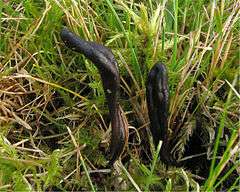Geoglossaceae
| Geoglossaceae | |
|---|---|
 | |
| Geoglossum glutinosum | |
| Scientific classification | |
| Kingdom: | Fungi |
| Division: | Ascomycota |
| Subdivision: | Pezizomycotina |
| Class: | Geoglossomycetes Zheng Wang, C.L.Schoch & Spatafora (2009) |
| Order: | Geoglossales Zheng Wang, C.L.Schoch & Spatafora (2009) |
| Family: | Geoglossaceae Corda (1838) |
| Type genus | |
| Geoglossum Pers. (1794) | |
| Genera | |
| |
Geoglossaceae is a family of fungi in the order Geoglossales, class Geoglossomycetes. These fungi are broadly known as earth tongues. The ascocarps of most species in the family Geoglossaceae are terrestrial and are generally small, dark in color, and club-shaped with a height of 2–8 cm. The ascospores are typically light-brown to dark-brown and are often multiseptate. Other species of fungi have been known to parasitize ascocarps.[1][2] The use of a compound microscope is needed for accurate identification.[3]
Systematics
| ||||||||||||||||||||||||||||||||||||||||||||||||||||||||||||||||||||||||||||||
| Cladogram showing phylogeny of Geoglossomycetes based on a four-gene dataset.[4] |
The fungi that are now included in the fungal class Geoglossomycetes were previously considered by mycologists to be a family (Geoglossaceae) within the class Leotiomycetes. The family Geoglossaceae sensu lato was previously defined with 6 genera and 48 species.[5] Early molecular evidence using ribosomal DNA[6][7][8] suggested that Geoglossaceae sensu lato was not a monophyletic group, and that the hyaline spored genera (e.g. Leotia, Microglossum, and Spathularia) were not allied within the same clade as the darker-spored genera (Geoglossum and Trichoglossum). Schoch et al.,[9] using a six-gene phylogeny including ribosomal DNA and protein-coding genes, found support for the establishment of a new class (Geoglossomycetes), containing the genera Geoglossum, Sarcoleotia, and Trichoglossum. Further molecular research resulted in the addition of Nothomitra (previously treated as a relative or synonym of Microglossum) to the group in 2011.[10] Glutinoglossum was circumscribed in 2013 to contain the species formerly known as Geoglossum glutinosum, and a new European species, G. heptaseptatum.[4]
Habitat
Earth tongues are commonly found in soil or among rotting vegetation.[11] In North America, they are commonly found in coniferous woodland, broad-leaved woodland and mixed woodland habitats,[12] whereas in Europe they are commonly found in grassland habitats[11][13] and are major components of the endangered waxcap grassland habitat.
References
- ↑ Seeler EV. (1943). "Several Fungicolous Fungi". Farlowia: 119–133.
- ↑ Rossman AY, Samuels GJ, Rogerson CT, Lowen R (1999). "Genera of Bionectriaceae, Hypocreaceae, and Nectriaceae (Hypocreales, Ascomycetes)". Studies in Mycology. 42: 186.
- ↑ "Family: Geoglossaceae." The Hidden Forest. 26 Aug. 2009 <http://www.hiddenforest.co.nz/fungi/family/geoglossaceae/geoglossaceae.htm>.
- 1 2 Hustad VP, Miller AN, Dentinger BTM, Cannon PF (2013). "Generic circumscriptions in Geoglossomycetes" (PDF). Persoonia. 31: 101–11. doi:10.3767/003158513x671235.

- ↑ Kirk PM, Cannon PF, Minter DW, Stalpers JA (2008). Dictionary of the Fungi (10th ed.). Wallingford, UK: CAB International. p. 279. ISBN 978-0-85199-826-8.
- ↑ Pfister D, Kimbrough JW (2000). "Discomycetes". In Mclaughlin DJ, McLaughlin EG, Lemke PA. The Mycota VII Part A. Systematics and Evolution. Berlin: Springer. pp. 257–81.
- ↑ Wang Z, Binder M, Schoch CL, Johnston PR, Spatafora JW, Hibbett DS (2006). "Evolution of helotialean fungi (Leotiomycetes, Pezizomycotina): A nucleear rDNA phylogeny.". Molecular Phylogenetics and Evolution. 41 (2): 295–312. doi:10.1016/j.ympev.2006.05.031. PMID 16837216.
- ↑ Wang Z, Johnston PR, Takamatsu S, Spatafora JW, Hibbett DS (2006). "Toward a phylogenetic classification of the Leotiomycetes based on rDNA data.". Mycologia. 98: 1065–75. doi:10.3852/mycologia.98.6.1065. PMID 17486981.
- ↑ Schoch CL, Wang Z, Townsend JP, Spatafora JW (2009). "Geoglossomycetes cl. nov., Geoglossales ord. nov. and taxa above class rank in the Ascomycota Tree of Life." (PDF). Persoonia. 22: 129–36. doi:10.3767/003158509x461486.
- ↑ Hustad VP, Miller AN, Moingeon J-M, Priou J-P (2011). "Inclusion of Nothomitra in Geoglossomycetes" (PDF). Mycosphere. 2 (6): 646–54. doi:10.5943/mycosphere/2/6/5.
- 1 2 L. Watson & M. J. Dallwitz (2009-06-20). "The Families of Mushrooms and Toadstools Represented in the British Isles".
- ↑ Mains EB. (1954). "North American species of Geoglossum and Trichoglossum". Mycologia. 46: 586–631.
- ↑ Nannfeldt JA. (1942). "The Geoglossaceae of Sweden". Arkiv för Botanik. 30A: 1–67.
- Cannon PF, Kirk PM (2007). Fungal families of the world. Wallingford, UK: CAB International. ISBN 0-85199-827-5.